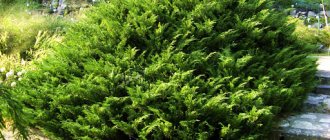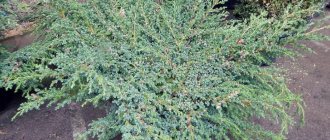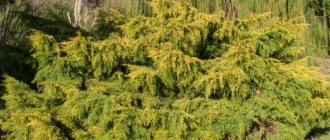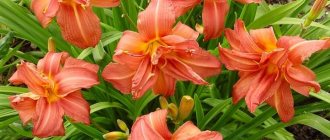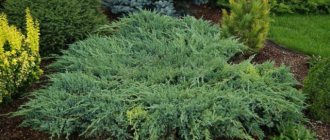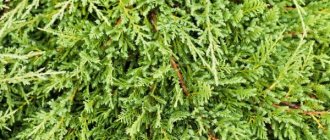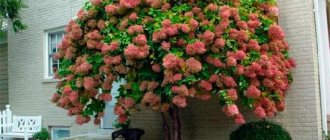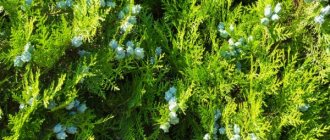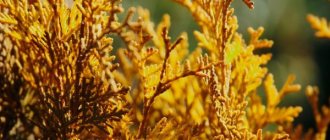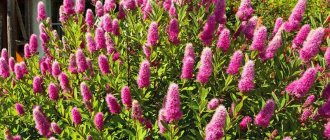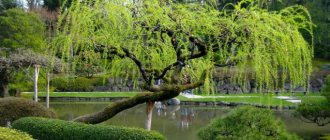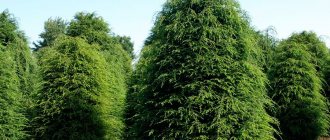Juniper Tamariscifolia, or Tamaris, is a beautiful evergreen garden plant from the extensive Cypress family (Cupressaceae). Ephedra looks great and goes perfectly with a variety of deciduous and coniferous plantings, various herbaceous annuals and perennials. Under natural conditions, Tamariscifolia grows in Asia, Europe, and the eastern part of Siberia.
In the treatises of the ancient Egyptians, Greeks and Romans, the healing properties of the juniper branches of Tamariscifolia were officially noted and recognized.
Juniper Tamariscifolia: general information about the variety
Juniper Tamariscifolia: photo in landscape design
Juniper Tamarisfocilia is a perennial coniferous plant and does not belong to a hybrid origin, but to a full-fledged variety. Cossack juniper Tamarisfocilia has high drought and frost resistance, so it can withstand various changes in weather. The variety is resistant to frosts down to -35 degrees; temperatures below will have a bad effect on the plant. Juniper Tamarisfocilia today is a very popular variety that almost every gardener uses to decorate their garden. In order for a crop to grow beautiful and healthy, it must be looked after and planted correctly. You will learn about all this in the article.
Varieties
Cossack juniper has 30 varieties, which differ in the color and shape of the needles. The most popular varieties of Cossack juniper include:
- Tamariscifolia;
- Variegata;
- Mas;
- Glauka.
Tamariscifolia
Juniper Tamariscifolia
Coniferous shrub up to 1 m high. The leaves of the juniper Tamariscifolia, located lengthwise on the branches, are characterized by a yellow-beige color.
In winter, the branches acquire a purple and blue tint. This type of Cossack juniper has small flowers (sometimes there are none at all).
Tamariscifolia resembles a dwarf tree. The place for planting shrubs should be sunny, the soil should be drained.
Unpretentious when growing and caring, tolerant of dry weather. Therefore, it is one of the favorite plants of amateur gardeners and highly qualified landscape designers.
Variegata
Juniper Cossack Variegata
An evergreen coniferous plant, up to 1 m wide and high.
The leaves are characterized by a yellow and marsh color, becoming brighter in winter. Variegata has the shape of a prostrate plant with soft, non-sharp needles.
Unpretentious in planting and care. Grows well in sun and moderate shade. The pruning period is from the first days of March to mid-July. Grows well in any terrain and weather conditions.
Mas
Juniper Mas
Coniferous shrub characterized by rapid growth. The leaves delight with their green shine for quite a long time.
The needles are soft green with a gray-violet coating. Mas reaches 2 m in height and spreads 10 m in diameter.
The planting site should be well lit; it does not like shade. When caring, you should be careful and regularly ensure that the soil on which the shrub grows is not oversaturated with moisture. This will lead to fungal disease of the juniper.
Glauka
Juniper Glauka
An evergreen coniferous plant, characterized by a spreading crown.
The leaves of this type of juniper are green-gray in color. The fruit is cone-shaped and dark brown in color.
The height of an adult bush is 1 m, and the crown reaches 3 m in diameter. The plant grows on any soil, but the planting site should be sunny. The shrub develops slowly. Juniper Glauka tolerates winter well.
Juniper Tamariscifolia: description of the variety
Juniper Tamariscifolia: photo
Juniper Tamarisfocilia grows at a fairly slow pace; during the season the plant can add about two centimeters, no more. After the plant reaches its maximum height, it will stop growing upward at all, but will continue to grow wider. This usually occurs at the age of 10-12 years, the maximum height reaches up to 40 centimeters. Many gardeners believe that this is an advantage of this variety, since it does not need to be shaped, and even if the juniper was given a non-standard shape, it will not disappear and will remain for a long time.
The needles of the Tamarisfocilia variety of juniper are small and have a slight point at the end, but the needles are quite hard, so it is possible to get injured by them. It has a light green color, but sometimes it can be green with a blue tint, which can be seen in the sun. The cones of the culture are round in shape and small in size, about 60-80 millimeters. Young cones, like the needles, are light green in color, but as the plant ages, the color of the cones changes and becomes bluish in color, and a layer of blue coating will also appear on them.
This variety does not require special care and grows well in different soils, for example, rocky or sandy soil. It is worth noting that, despite its high drought resistance, the variety does not tolerate excess moisture and will not be able to develop in swampy soil. In such soil it will simply die.
Note: The landing site should be well lit from all sides, and there should be no groundwater or swamps near it.
Description of Cossack juniper
Cossack juniper is a bush or small trees reaching a height of 1-1.5 meters. It is capable of growing uncontrollably, rooting lateral branches and forming thickets. It is much less common to find it in the form of a small tree with a crooked trunk. Young needles are 4-5 mm, needle-shaped. Older needles become flattened, fitting tightly to each other like scales. When the cones ripen, small seeds of up to 4 pieces are formed. in one fruit. Male and female flowers are on different plants.
Juniper Tamariscifolia: photo on the site
Since the variety grows in width and forms a kind of elongated canvas, it is called horizontal juniper. The variety is often planted in a flower bed or lawn; it looks great and decorates the area. Also often used is zoning the territory using this variety.
Juniper Tamarisfocilia can be used as a living territory limiter, that is, a small fence. This variety gets along well with absolutely all plants, so it can be used in various combinations. Designers who decorate large spaces often do this, combining different crops or different varieties of juniper, which looks very impressive. Plants in yellow, red or orange shades will go well with the green-blue needles of Tamarisfocilia. Juniper Tamarisfocilia can grow on a site for many years, but this will only happen with proper care.
Note: This variety has one negative side - it is that its berries are poisonous, so it is better not to plant this variety if you have a small child.
Types and varieties
Juniper Cossack Tamariscifolia
Cossack juniper Tamariscifolia, a wonderful high-mountain variety. The plant almost does not rise in height. Over 10 years of life it will not exceed 30 centimeters, but in width its long, soft branches occupy an area of up to two meters. Long whip-like branches form a dome, dotted with small needles, collected 3 pieces in a bunch. There are several varieties with varying degrees of color intensity and different shades. The fruits are formed at the end of summer, with a diameter of 5 to 8 ml, covered with a bluish coating. It cannot be used for medicinal purposes, as the fruits are poisonous. Thanks to its branched root system, it is perfect for alpine hills, grows well on poor soils, and is frost-resistant. Suitable for growing in urban environments, as it easily tolerates gas pollution.
Juniper Glauka
Juniper Glauka is one of the varieties of Cossack juniper. Its long graceful branches can occupy an area up to 3 meters in diameter. In this case, the height of the plant will not exceed one meter. Like all representatives of the species, it prefers well-lit and drained places. In winter, the gray-blue needles acquire a bronze tint, adding piquancy to the winter landscape.
juniper mas
The funnel-shaped crown of the Mas variety eventually acquires a wide-spread shape, which can occupy an area of up to 8 meters in diameter. The bush grows up to 2 meters in height, but it is often pruned and not allowed to grow much. The needles become purple in winter and bluish-green in summer. Feels good in open spaces and partial shade. It will not take root in areas with close groundwater and in saline lands.
Juniper Cossack Variegata
One of the compact representatives of Cossack junipers is Variegata. The diameter of an adult plant is about 1.5 meters with a height of only 1 meter. The curved tops of the shoots resemble the spray of fountains. The ends of the shoots are cream-colored, the rest of the plant is green. The species is frost-resistant, undemanding to soil and does well in direct sunlight. Propagation by seeds is difficult, requires stratification, and seedlings will appear only after 1-3 years. In the first year of life, the bush needs shelter in winter. Despite its unpretentiousness and low watering requirements, this species is best watered during dry seasons. In early spring, it is necessary to apply fertilizers (nitroammofoska) from 20 to 50 grams per m2, and in the fall, mulch with sawdust up to 8 cm.
Juniper Arcadia
The ground cover representative of Cossack junipers is Arcadia. In ten years, the plant will grow only 30 centimeters, but will cover a space around itself one meter in diameter. Prefers sunny areas of the garden and watering during the dry season. Also, after planting, it is necessary to regularly water the young plant and be sure to mulch in the fall. In the evening, it is good to sprinkle (spray the needles).
Cossack juniper Blue Danube
Blue Danube is a fast-growing juniper. In one year, it can increase in diameter up to 20 centimeters, but will not exceed 1 meter in height. The soft, scale-like needles are colored bluish-blue. It will grow well in open spaces and in partial shade. Does not like dry air and needs sprinkling. In the first years of life, it is advisable to cover it for the winter. Perfect for the foreground of coniferous flower beds in combination with perennial flowers and for rockeries.
Juniper Rockery Jam
Rockery Jam is a relatively recently developed variety by Dutch breeders. With low growth, the plant can cover an area of up to 3 meters. On long branches there are both prickly and needle-like needles. It quickly grows in width by 20-25 centimeters. It will survive on poor soils, but fertile soil will reveal all its qualities. Unlike other varieties, it thrives in well-moistened soils. It tolerates pruning well; it will allow you to form it into a ground cover plant.
Juniper false Cossack
False Cossack - the species is found in the Alps in the wild. It climbs along rocks and screes to a height of up to 4000 meters above sea level. In the central part of Asia and Siberia it can be grown as an unpretentious garden plant, not demanding on the soil. The ability to withstand severe frosts and dry seasons makes it an indispensable garden plant. The plant form is a creeping bush. The needles are soft, elliptical in shape, green.
Juniper Cossack Hicksii
Hixi is a variety with a wide-spread crown up to 2.5 meters. The plant does not grow higher than 1.5 meters. The needles are dark green or silver-green. It grows slowly. It will feel better on loose and slightly acidic soils with bright lighting. Watering is necessary in the first week after planting during dry seasons. For the winter, cover the soil around the plant with peat flour or sawdust. The layer should be from 5 to 10 centimeters.
Juniper Cupressifolia
Juniper Cupressifolia is a low-growing variety that can cover an area of up to 4-5 meters around itself. The species is winter-hardy; temperatures down to -45 degrees will not harm the plant.
Juniper Erecta
Erecta is a member of the erect variety of juniper. The height of the plant can reach 2 meters. The shape of the crown of an adult plant is pyramidal, with branches directed upward. Soft, dark green, scale-shaped needles. The plant is not demanding of dry air and does not require sprinkling.
General information about landing
This variety is photophilous and heat-loving, so the place should be well lit and not have any shading. There should be a distance between crops of about 60-200 centimeters, it depends on how large the planting material is. In any case, the distance should be sufficient, since the juniper will become wider and wider every year. The larger the planting material, the larger the hole should be. Usually for a small bush they dig a hole about 60 centimeters deep, for an adult about 80 centimeters.
Note: Do not forget about moderate watering, as excess moisture will have a bad effect on juniper.
It is also recommended not to tempt fate and not allow the soil to dry out. Fertilizing should also be applied 2-4 times a year.
If Tamarisfocilia is well cared for, it will delight the gardener with its beauty.
Preparation of planting material, site and soil
Before planting, you need to prepare planting material. First you need to pay attention to the roots; if the root system is open, then the planting material is planted in open ground in the first half of September. The root system of the plant must be healthy and free from signs of disease. Before planting, the root system of Tamarisfocilia is placed in water at medium temperature for 180-210 minutes, and then treated with a rooting agent. Or you can immediately add the rooting agent to the water and soak for 180-210 minutes, there is no difference.
Note: The average height at maturity of the variety is 40 centimeters.
Juniper should be planted in prepared soil. Firstly, the place for planting must be suitable for the variety, that is, it must be well lit; in the best case, this place should be on a hill. It is also worth considering the presence of groundwater, since the roots should not come into contact with it.
Reproduction methods
There are several ways to propagate Cossack juniper Tamariscifolia:
- seminal;
- vegetative (cuttings and layering).
The seed method and propagation by layering are practiced by specialized nurseries. At home, these methods are not effective and do not justify the financial and time costs.
Experienced gardeners agree that the most effective and efficient method at home is the vegetative propagation method by rooted cuttings. Cuttings ensure that you get high-quality propagation material every time. Cut shoots from the mother bush are used as planting material. Branches are separated using treated garden tools.
To achieve the desired effect, cut shoots are treated with root growth stimulants and planted in special planting containers with soil for rooting coniferous plants. You can prepare the soil mixture yourself from equal parts of sand, peat and turf soil.
Before planting cuttings, containers (boxes) and soil are disinfected, and the bottom of the containers is formed with good drainage material.
After placing the cut shoots in planting pots, the seedlings are shed with settled warm water, and the cuttings are covered with plastic film to create a greenhouse effect. Cuttings are germinated in well-lit and ventilated rooms (greenhouses). After the first young side shoots appear, the shelter is removed. Rooted cuttings of the Cossack juniper Tamariscifolia are planted for a permanent “place of residence” after about three years.
After the young bushes have grown stronger in containers, the Tamaris juniper is planted in open ground.
Landing instructions
This variety is not picky about the type of soil, so planting can be done in any soil, just not in swampy areas. Sandy, neutral, slightly acidic soil is perfect for planting. Do not forget about the illuminated place, since only in this case the plant will fully develop.
- First you need to prepare the hole. The pit should correspond to the dimensions, about 65 centimeters wide and about 55-65 centimeters deep.
- Expanded clay or broken brick should be poured into the hole; the layer should be 15 centimeters. This material will serve as good drainage, which will push excess moisture away from the root system.
- On top of the drainage you need to pour a mixture that includes peat, sand and turf.
If a gardener plans to make a small fence out of juniper, then the distance between crops should be about 60-80 centimeters. If there is a single planting, then planting should be done at a large distance of 2-3 meters, depending on the size of your plot.
Rules for planting and care
The plant is unpretentious and can grow:
- in sunny areas and in the shade;
- on level ground and on a slope;
- on soil of any composition, except pure peat and clay.
The healthiest and most beautiful bush will be if it is placed in the sun or in lace shade, choosing an area with light and loose soil. In waterlogged areas, juniper grows poorly and is damaged by rot.
The optimal soil composition for this type of conifer is: non-acidic peat, crumbly turf soil and sand, in a ratio of 2:1:1. You can use fine gravel instead of sand.
The healthiest and most beautiful bush will be if it is placed in the sun or in lace shade, choosing an area with light and loose soil.
Advice. Juniper of this variety grows well on slopes, performing not only a decorative function, but also keeping the soil from sliding.
It is recommended to plant seedlings in the spring, in April - May. But, with proper care, planting can be done throughout the warm season, until September. You cannot plant conifers before the onset of cold weather; its root system will not have time to adapt to the new location and the seedling will die.
Landing
For the plant, holes are dug, slightly larger than the volume of the earthen coma in which the conifer is located. A layer of stones or expanded clay must be poured onto the bottom of the pit for drainage. The thickness of the rocky pillow is at least 15 cm.
The roots of the sprout are covered with soil, leaving the root collar on the surface.
Prepared soil is poured onto the drainage, into which mineral fertilizers for coniferous plants are added, according to the specified dosage. For example, the drug “Green Needle” will require 1 tablespoon for each well. The planting hole is filled with soil by a third or half.
A seedling is lowered into the center of the hole, straightening its roots. Before planting, the plant is removed from the transport pot and soaked in a fungicide solution to prevent the development of root rot.
The roots of the sprout are covered with soil, leaving the root collar on the surface. Afterwards, the bush is watered with water and soil is added to those places where the soil has settled and voids have formed.
Plantings of coniferous plants are usually mulched with pine needles, spruce bark, small decorative pebbles (they are poured onto agro-fabric previously spread on the ground), and peat. Mulch, 15-20 cm thick, helps retain moisture in the soil and suppresses the growth of weeds.
Watering and fertilizing
Regular and abundant watering should be carried out only 7-15 days after planting, then watering depends only on the condition of the soil. The ideal option for the plant would be light watering in the form of rain. Rain has no effect on the plant, even heavy and prolonged rains. But at the same time, the variety simply does not tolerate swampy areas and cannot develop there. Otherwise, the plant dies. Usually, juniper is watered only 2-3 times during the whole season.
Fertilization is quite important for Tamarisfocilia. With the onset of spring, you need to use mineral fertilizer. In the second half of April or the first half of May, Fertika is used. To do this, the drug in an amount of 10 grams is mixed in 5 liters of warm water.
Rules of care and feeding
Juniper Blue Alps: description, planting and care
Cossack juniper has gained wide popularity due to its unpretentiousness. The plant requires almost no care and is tolerant of weather changes. However, in order for the bush to grow and please its owners for many years, it needs care. To do this, you must follow the following recommendations:
- Water thoroughly in the first few weeks after planting.
- remove weeds from around every day.
- loosen the soil at the planting site;
- use fertilizer in the spring.
- cover the soil with peat for the winter.
As it grows, the juniper will become much easier to care for. Tamariscifolia easily tolerates rainy weather, but in a swampy area or in an area with constant stagnation of water, it may die.
Tamariscifolia grows extremely slowly, so there is no need to constantly trim the branches. However, it is necessary to shorten the length so that the bush does not fill the entire space and does not look untidy. It is enough to do this once a year. Such manipulations do not harm the plant, provided it is trimmed correctly. To do this, you need to pinch off the ends of the bush, thus creating a shape and directing the germinating needles in the desired direction. The bush can be given any shape. It is advisable to treat the places where branches are cut with resin.
Feeding juniper
Pruning and crown formation
Juniper Tamarisfocilia grows very slowly, so pruning is done very rarely. It is still necessary to shorten the plant for its convenience and for better development. Also, the culture will become neater and look more elegant. In juniper, dry and old shoots, as well as faded branches, must be pruned. Pruning must be done carefully so as not to injure the plant. You need to cut off the ends a little, this is how the new shape will appear. After pruning, you need to cover the cuts with garden varnish.
The plant may or may not form. To form, you need to cut off the ends a little, this is how a new shape will appear. Formation depends only on the imagination of the gardener. If he wants a regular canvas, then the juniper is not touched, but if he wants to form any pattern, then the formation is done.
Mulching, loosening
Choosing the right place, preparing it, as well as preparing planting material, that's not all. Maintenance and some work must also be performed. It is necessary to mulch the soil immediately after planting the seedling. For mulching, peat, soil, hay or straw are used. Mulching allows you to retain moisture and heat in the soil. The layer for mulching depends only on the season. The colder it is, the larger the layer, and on average it should be about 6 centimeters.
It is necessary to ensure the supply of oxygen to the soil; for this it is necessary to loosen the soil. It is necessary to loosen the soil after each watering, after rain. And it is imperative that before loosening, weeding must be carried out, that is, there should be no weeds or other debris.
Use in landscape design
Cossack juniper is loved by landscape designers. Its evergreen crown will refresh the landscape at any time of the year, and in combination with the contrasting colors of barberry bushes or perennial flowers it is an excellent background. The ability to use it as a ground cover plant on poor soils allows you to decorate rock gardens, rockeries and borders with it, forming a contrast of emerald greenery against the background of gray stones. This species can be grown not only in flowerbeds and containers - some species are used for indoor cultivation, giving them the form of a bonsai. Despite the fact that the plant is poisonous, like all conifers, it is capable of releasing phytoncides and thereby purifying the air in the room.
Cossack juniper is a beautiful species that does not require special care and can withstand severe frosts, which allows even non-professionals to grow it. The variety of shapes and the ability to shape the bush makes it a favorite of landscape designers.
Preparing for winter
Since the Cossack juniper Tamariscifolia is highly resistant to frost, it can also be grown in the northern regions. Whether to cover the bushes for the winter or not is a decision only for the gardener himself, but this is not necessary, since juniper will tolerate temperatures of about -30 degrees well. If you understand that you have a very cold winter and the temperature is lower than -30 degrees, then you need to cover the plant. Preparing juniper for wintering involves pruning dry shoots, diseased parts of the crop, and treating it with an antifungal drug. After trimming, the sections are treated with an alcohol solution.
Rules of care
Since juniper is considered an unpretentious crop, it will not cause much trouble to its owner. However, the plant cannot be left completely unattended.
By following the basic rules of agricultural technology given below, you can grow a beautiful spreading shrub with a lush crown, which will become a real decoration of your site.
Watering and spraying
Like all conifers, juniper is drought-resistant, so it should only be watered during drought. And even in this case, 2-3 waterings per season will be enough. This will not affect the growth rate of the crop at all. Rather, on the contrary, excessive watering and stagnation of moisture at the roots can destroy the plant (Figure 3).
Additional care measures include periodic spraying of the plant, which is carried out in the evening and only if the weather is too dry. Otherwise, we can say that juniper grows slowly and gets enough moisture from natural precipitation.
Figure 3. Shrub watering is required only during severe drought
In order for the crown of the bush to reach a large diameter, after each watering or heavy rain it is advisable to carefully loosen the soil around the trunk, while simultaneously removing weeds.
Fertilizer and feeding
Fertilizing the conifer will also not cause much trouble. In the spring, the bush is fertilized with Nitroammophoska, adding fertilizer at the rate of 30-40 grams per square meter. Also, for the formation of a spreading crown and stimulation of flowering, Kemira-plus fertilizer is suitable, 20 grams of which are diluted in 10 liters of water (Figure 4).
Figure 4. Fertilizers are applied mainly in early spring
In the future, caring for juniper is even easier: heat-loving varieties are covered for the winter, and bushes that are too spreading are pruned to form a crown of the desired shape.
Pruning and shelter for the winter
To maintain the decorative appearance of the shrub, it needs to be trimmed periodically.
It is important to take into account that trimming juniper is only possible on mature bushes that have already grown enough green mass and need to form a crown
Figure 5. Only mature shrubs are pruned
Pruning Cossack juniper is not difficult. In the spring, sanitary cleaning of the bush is carried out, removing dry and damaged branches. In the fall, when the plant begins to prepare for the dormant period, the crown is formed by removing or shortening the necessary shoots (Figure 5).
If we talk about the winter hardiness of juniper, then there are special frost-resistant varieties that feel great in winter even without special shelter. It is advisable to mulch heat-loving species with peat, dry leaves or other organic material. In the spring, such cover is removed so as not to provoke rotting of the root collar.
How does juniper Tamariscifolia reproduce?
This variety can be propagated by several methods:
- Using cuttings.
- Using seeds.
- Using layering.
The most popular and successful method is the method that uses cuttings. In this case, rooting occurs 2-3 times faster than in other methods. Cuttings should only be taken from a perennial plant. After the cutting has taken root, you must wait 2 years. After 2 years you can plant them in the garden. Propagating juniper from seeds is very difficult and time consuming. This method should only be used by experienced gardeners, as a beginner will not cope.
Basic plant care
- Watering. As mentioned above, it is rarely required. If the summer is not particularly dry, limit yourself to 2-3 times throughout the entire season. One plant will use from 10 to 30 liters. After the procedure, slightly loosen the soil around the bush so that it does not form a crust.
- Spraying. It’s worth remembering them in the heat. Tamaris should be sprayed only in the evenings, at least once a week.
- Feeding. In spring, the bush should be pampered with mineral fertilizer. In April or May, give one plant “Kemira-Lux” (20 g of substance per 10 liters of water) or “Nitroammofoska” (about 35 g per square meter of near-trunk soil). In the fall, the bushes are generously mulched with organic matter - but in the spring, do not forget to rake this peat or fallen leaves aside so that moisture from melting snow does not accumulate in them and the root collar of the juniper does not begin to rot.
- Reproduction. This bush can be propagated by seeds (a method for the pros, as it is very time-consuming and troublesome), as well as vegetatively - by grafting, cuttings, layering.
A practicing gardener who is well acquainted with the vagaries of different plant varieties will tell you about other subtleties of caring for this shrub:
What does Tamariscifolia cause?
This culture is very afraid of rust (fungal disease). Therefore, Tamariscifolia should not be planted near an orchard where pear or apple trees grow - it can contract this disease from them. Roses can also suffer from rust.
This is what an infected shoot looks like:
What to do if you detect even the very first signs of the disease:
- Cut off the compromised shoot, above the disease, and burn it.
- Spray the bush with fungicide.
- Even if the bush appears healthy, you can carry out prevention: treat it from mid-July to mid-September, twice a month, with Topaz or another similar fungicide.
But rust is only the most common disease. Unfortunately, juniper owners also encounter other diseases, both fungal and ordinary sunburn. An experienced gardener will tell you how to distinguish one disease from another, make a correct diagnosis of a bush and cure your pet.
First part of the video:
Second part of the video:
Trimming
The shrub needs two types of pruning: formative (if the branches grow in the wrong direction, on the one hand they grow too quickly, or the gardener wants to “pile” something original from the bush) and sanitary (removal of excess branches that unnecessarily thicken the crown, as well as diseased ones). , dry, frozen or simply broken).
When to prune a bush? The best time is cold autumn or early spring, when the temperature is within 5 degrees.
There is an opinion that juniper shoots should not be cut, but plucked out - in this case, you will improve the process of tillering, branching and the juniper will become more magnificent.
What can cause diseases of the Cossack juniper Tamariscifolia?
This variety has average resistance to diseases and pests, so it can often get sick without proper care. Firstly, when spring comes, you need to take care of the juniper crown; it must be protected from sunlight, as it causes burns. These burns cause the needles to turn yellow and fall off. The plant should be covered with gauze; it allows the plant to breathe and perfectly protects the juniper.
Yellowing of the crown may be due to infection with a fungal disease. If the fungus is not treated, it will destroy the crop in 2 years. Trimming the affected parts and treating with alcohol will help get rid of the fungus. To prevent fungal diseases from infecting the plant, it is necessary to carry out preventive treatment using fungicides.
Diseases and pests
Cossack juniper Tamariscifolia, like many plant species, is subject to the appearance of pests and diseases during the growth process. At the beginning of spring, when the sun is shining brightly, there is a chance of getting sunburn. As a result, the needles turn yellow and fall off. In this case, it is recommended to cover the juniper from direct sunlight in the first half of March, insulate the ground and use warm water during watering.
In addition, the crown may begin to turn yellow if the plant has been affected by a fungus. This type of disease can destroy a plant in 2-2.5 years. It is possible to defeat the disease. To do this, you need to cut off the diseased parts and treat the cut areas with alcohol.
Advice! As a preventive measure, it is recommended to periodically spray juniper with fungicides.
